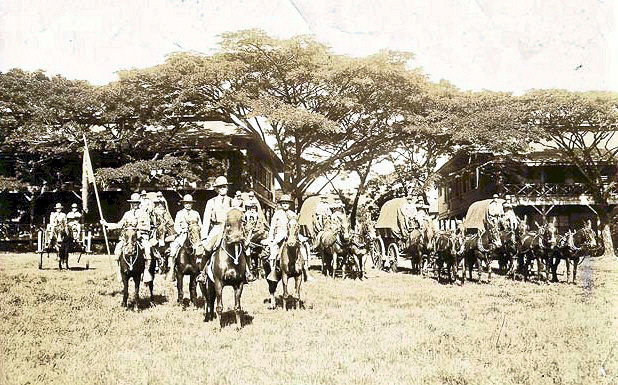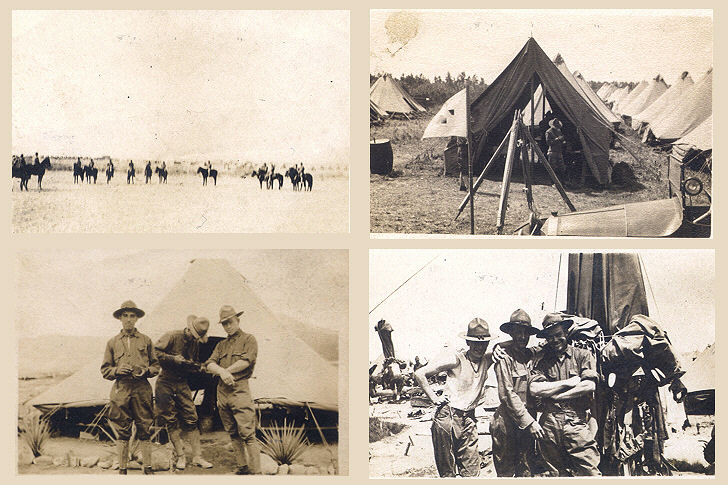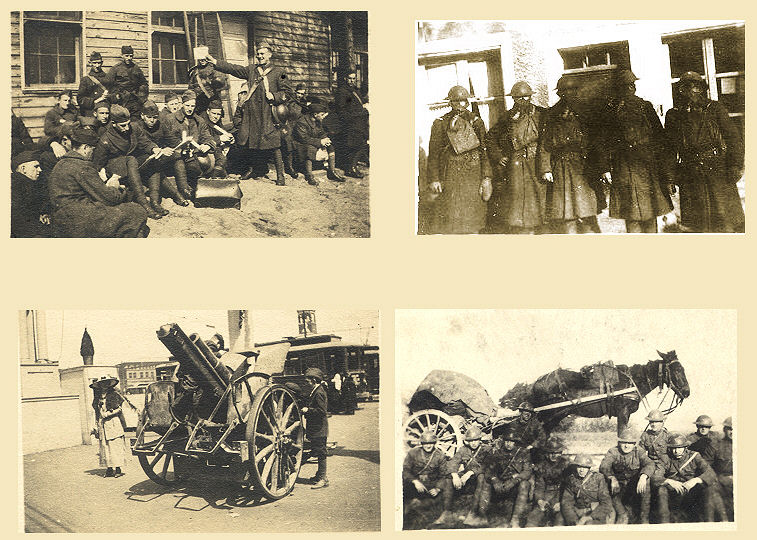Contributed by John Cervone, U.S. Army, Retired
Click on Image to Expand
Battery A, Ready for Movement
On 15 May 2006, President George W. Bush announced the
initiation of “Operation Jump Start,” a plan to use National Guard troops to
assist the Border Patrol in restoring order to the region. When
Operation Jump Start concluded in July 2008, over 30,000 Army and Air Guard
personnel in all 54 states and territories had served on the border. The National Guard had also been deployed to the Mexican border
90 years earlier, and many units
repeated the experiences of their predecessors. Here is the story of one of
those units.
In 1916, as the United States watched World War I unfold in
Europe, General John J. Pershing led an expeditionary force against Pancho
Villa. Light Battery A, Rhode Island Field Artillery, was called into federal
service 19 June 1916 for duty with General Pershing during the Mexican border
conflict. Members of the same unit would repeat history in August of 2006, when
they were again deployed to the Mexican border, as part of "Operation Jump
Start." In 1918 the Rhode Islanders also saw action during WWI with the
American Expeditionary Force re-designated as the 1st Battalion, 103rd
Field Artillery, an element of the 26th "Yankee" Division.
History records that only one regiment of
the National Guard, the 2nd Massachusetts Infantry, actually entered
Mexico with Pershing's Expedition. The Rhode Islanders along with the bulk of
the National Guard troops would not cross the border into Mexico but were used
mainly as a show of force. But be that as it may, as you have previously read,
activities on the border were far from dull. The troops were on constant alert
as border raids were still an occasional nuisance. As it later proved, the
expedition was an excellent training environment for the officers and men of
the National Guard, who were recalled to federal service later on in 1917 for
duty in World War I. Many National Guard leaders in both World Wars traced
their first federal service to the Mexican Expedition.
Military deployments are not always as simple as they are
presented by Hollywood and those who have never been deployed. A deployment is
hard work with little appreciation. A deployment to the desert can be both
dangerous and strenuous. Only someone who has faced this type of danger truly
understands the meaning of the word “deployment.” Remaining in the rear with
the gear does not qualify even one iota. The troopers of the 103rd
Field Artillery experienced this type of danger in 1916 and later on in 2006.
Here are some of the situations they endured while in Mexico. Not everyone is
wounded or killed in battle. Sometimes the daily rigors of life in the desert
can also take their toll on soldiers.
Click on Image to Expand
Battery A, on the Mexican Border
The unit left Quonset Point on 9 June 2016 and
had a very rapid trip to the border. The trip took only four days in all. While
deploying to the border, they experienced firsthand how unprepared the nation
was for transporting troops to their designated positions. They were among the many units heading to the
border, by train, who did not receive proper berthing accommodations until
reaching Kansas City. The railroads
seemed to lack even the proper number of trains necessary to move thousands of
troops from one section of the country to the other. They even encountered delays upon arriving in
El Paso. They had to wait hours before vehicles arrived to shuttle them to Fort
Bliss.
The 103rd arrived at Fort Bliss after midnight and
did not unload their gear until the following day. They were assigned to an
area known as “Morningside Heights” and were greeted by fifty-seven varieties
of cactus, snakes, lizards, scorpions, tarantulas, and hot burning sand. A large ravine ran right through the middle
of the camp which was later to be found out became a raging river whenever it
rained hard for more than fifteen minutes. As it rained about four or five
times a day needless to say the area was not suited to an artillery unit.
So they set up camp in this wasteland and with temperatures
of over 120 degrees went to work with shovels, picks, and axes to set up a
suitable camp. It took them over ten days to actually become acclimated to the
heat and drinking water was always in high demand. After much hard work the
camp was finished only to be told by a camp inspector that they had been
assigned to this area incorrectly and were ordered to move to another location.
They were moved twice more after clearing land and making it habitable for
living.
All of this sounds very familiar to anyone who has been
involved in a military deployment. Hurry up and wait or hurry up and move. I
imagine that in many ways this keeps a soldier on his toes and never gives them
any time to become complacent or bored.
One of the biggest problems facing the troops in El Paso was
receiving the supplies they needed. Many of the outfits stationed there were
poorly equipped when they arrived and were in the same state of disrepair when
they left three months later. Much of
the equipment that was furnished was old and antiquated. The 103rd
had to wait six weeks for cots for the men to sleep on. Before that many of
them slept on the ground. As the 103rd
was equipped with their own cooks, their meals were not as bad as some other
units, but still lacked in quantity and taste.
Click on Image to Expand
Battery A, in France, 1918
One of the daily missions for the troops was breaking in
“green” mules. The key to surviving this type of training was to avoid their
hooves. Many a trooper discovered to their chagrin that a mule kicks with his
front and rear hooves. The unit had over 68 mules attached to it so everyone
was given a chance to prove their prowess and stamina with these four-legged
troopers.
Another hazard to the troops was sandstorms, some of which
could be compared to miniature cyclones. These weather events would come
whirling through the camp taking up to whatever came in their way from clothes
to tents. Hats would disappear never to be found again. These miniature
cyclones were coming at such a constant rate that the men began setting up
betting pools on when they would strike.
The general health of the men was good and on the whole most
came back in better health than they arrived with. There were serious — and one
fatal — accident from kicks by mules and falls from bucking horses. The days were
spent waking to reveille, then mess call, cleaning out the stables and then
feeding and watering the horses and cleaning equipment. They drilled with their
horses, practicing leg signals and various riding movements including hurdling
obstacles.
Click on Image to Expand
Battery A, North of Château-Thierry
By November of 1916, the Rhode Island unit returned home, but
not for long. They were called back into federal service on 25 July 1917. The
unit was then drafted into the U.S. Army on 5 August 1917. The unit was stationed at Camp Curtis Guild,
Boxford, Massachusetts, where it was assigned to the new 103rd Field
Artillery, 26th Division, AEF. They were deployed to France, where they served
with distinction during the Second Battle of the Marne and the St. Mihiel and
Meuse-Argonne Offensives. The
unit was demobilized at Camp Devens, Massachusetts, 29 April 1919.





No comments:
Post a Comment